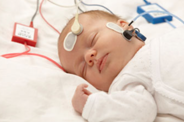Types of objective hearing tests
The type of test used by a clinician to assess a child’s hearing is much dependent upon their developmental age. These tests are mostly carried out on babies and are very similar to those which form part of the Newborn Hearing Screen, however, they can be used to test all ages of children. They often require the child to be asleep or still for a period of time.
Otoacoustic Emissions (OAE)
This test is the initial test completed in the Newborn Hearing Screening Programme. However, it can also be used throughout routine Audiology. An OAE is the response from the inner ear to a sound stimulus. The OAE response is measured by placing a small tip at the entrance of the ear canal. The test can be affected by a very mobile child, wax and middle ear pathology (such as glue ear).
Auditory Brainstem Response (ABR) For this test, the skin is first cleaned with a gel and then sticky sensors are placed behind each ear and on the forehead. Whilst the child sleeps, different pitches of sound are then played using headphones and the activity of the auditory nerve is picked up. The test enables us to accurately assess the whole hearing pathway up to the brainstem.
For this test, the skin is first cleaned with a gel and then sticky sensors are placed behind each ear and on the forehead. Whilst the child sleeps, different pitches of sound are then played using headphones and the activity of the auditory nerve is picked up. The test enables us to accurately assess the whole hearing pathway up to the brainstem.
ASSR
For this test, the skin is first cleaned with a gel and then sticky sensors are placed behind each ear and on the forehead. Different pitches of sound are then played via headphones. The test enables us to test several sound frequencies at the same time.
Tympanometry
Tympanometry assesses the middle ear status and eardrum movement. This is achieved by placing a soft tip at the entrance of the ear canal. The pressure is then gently changed in the ear canal and the movement of the eardrum is measured via the tip and displayed on the machine. The Audiologist will review the eardrum movement and collate with your child’s hearing assessment results.
Tympanometry is often used in children as it will highlight whether they have middle ear effusion (e.g. glue ear) which is a common cause of hearing difficulty in children and requires active monitoring.
